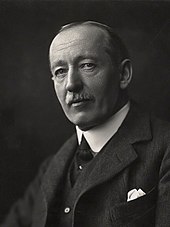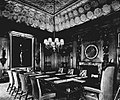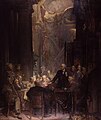Naval Officers of World War I.

|
| Naval Officers of World War I. |
|---|
| Arthur Stockdale Cope , 1921 |
| Oil on canvas |
| 264 × 514 cm |
| National Portrait Gallery, London |
Naval Officers of World War I (Navy officers of World War I) is a painting by Arthur Stockdale Cope (1857 to 1940) from the year 1921. It is now in the National Portrait Gallery in London . Arthur Stockdale Cope was one of the most significant British portrait - painter of his time. The original name for the painting was Some Sea Officers of the Great War (Some naval officers of the Great War) .
prehistory
Shortly after the end of the First World War , the South African financier Abraham Bailey (1864–1940) commissioned three life-size group portraits from the National Portrait Gallery in London , which were intended to recognize the great importance of Great Britain's army , navy and politicians for victory in World War I . Bailey offered to pay £ 5,000 (about £ 230,000 today) for each of the three paintings and to donate them to the National Portrait Gallery upon completion. The Chairman of the Board of Trustees , Harold Arthur Lee-Dillon , sent a letter to Arthur Stockdale Cope in January 1919, asking him to make a painting with the main statesmen of the British Empire during the Great War.
Just two days later, Cope answered and thanked him for the offer to paint one of the group portraits. However, he was dissatisfied with the group of people intended for him and asked to be allowed to portray the naval officers. As a reason, he cited his personal connection with higher ranks in the armed forces and in particular with the navy . He also admitted that he was of little interest in politics. The Board of Trustees granted Cope this request. Before him, John Singer Sargent , the portraitist of General Officers of World War I , had already refused to paint the group picture with the statesmen. Finally, James Guthrie agreed to do the painting Statesmen of World War I with the leading politicians of the First World War. All three group portraits are still part of the National Portrait Gallery's collection today.
Preliminary work

A list of the naval officers to be painted was drawn up by members of the Board of Trustees with the participation of Abraham Bailey, the founder of the three group portraits. It included twenty-two people, including Rear Admirals (Rear Admiral), Vice-Admirals (Vice Admiral), Admirals , Commodores (Admiral of the Fleet), Commander (Commander-in-Chief) and First Sea Lord (First Sea Lords). It is noteworthy that two of the First Sea Lords, John Fisher, 1st Baron Fisher and Henry Bradwardine Jackson , were not taken into account, which was met with incomprehension when the painting was first presented. Fisher was First Sea Lord until 1910 and was recalled when the First World War broke out in 1914. After arguments with his superior Winston Churchill , the First Lord of the Admiralty , about the tactical approach of the British armed forces in the Battle of Gallipoli , Fisher resigned from his office in protest in 1915 and refrained from any further military influence. Presumably, therefore, he did not want to be shown in the group portrait. One reason for Jackson's absence could be the lack of space on the painting.
The Board of Trustees organized meetings with those depicted for all three group portraits. Between 1919 and 1921, Cope, Sargent and Guthrie made numerous pencil drawings and studies in oil paint . In contrast to the generals and statesmen, only a few of the naval officers' sketches have survived in museums. Some could also be in private collections.
Portrait studies (selection)
completion
Arthur Stockdale Cope completed his group portrait in 1921. It took John Singer Sargent an extra year to complete. James Guthrie was not able to complete his painting until 1930 due to numerous interruptions due to illness. In their portraits, Cope and Guthrie arranged the naval officers and statesmen vividly and in relation to one another. Sargent decided not to introduce a similar narrative motif. Rather, he grouped the individual portraits next to one another without establishing a relationship between the figures.
In contrast to Sargent and Guthrie, who positioned their characters in a fictional room, Cope chose a real setting for the gathering of naval officers. The meeting will take place in the Admiralty Board Room of the Old Admiralty Office in Whitehall , City of Westminster . The room still has almost the original furnishings from 1725, when the architect Thomas Ripley completed the admiralty building. On the wall is an 18th century wind dial, surrounded by nautical carvings made from limewood. The dial was mechanically linked to a metal flag on the roof so that the senior officers could always read the wind direction during their meetings. On the left wall there is still Leonardo Guzzardi's portrait of Lord Nelson .
In this room the dispatches from Nelson and other naval commanders were read, including those of the victory in the Battle of Trafalgar and of Nelson's death. According to a naval correspondent, no consultations or conferences took place in this room during the First World War. Important problems were almost always discussed in the room of the chief or the deputy chief of the naval staff, because the necessary maps and documents were available there. It is likely that some of the officers pictured never entered the Admiralty Board Room. Due to the historical reference, Cope chose this room as the backdrop for his group portrait.
Of the twenty-two naval officers, fifteen are shown standing and seven seated. In the foreground is Fleet Admiral David Beatty, 1st Earl Beatty , Commander in Chief of the Grand Fleet . On the far right sits his predecessor as Commander in Chief, Fleet Admiral John Jellicoe, 1st Earl Jellicoe , who was First Sea Lord from 1916 to 1917 . Similarly exposed as Beatty is the last First Sea Lord of the war, Fleet Admiral Rosslyn Wemyss, 1st Baron Wester Wemyss , on the right edge of the picture . On the far left, in the background of the room, are the three officers who did not survive the sea war: Rear Admiral Robert Arbuthnot, 4th Baronet , Admiral Christopher Cradock and Rear Admiral Horace Hood . Lord Nelson seems to be looking down on these three from his painting.
The painting was first exhibited at the National Portrait Gallery in 1921 and remained there until the 1960s. Because of its poor condition, it was no longer visible for several decades. After restoration, it was reopened to the public in May 2014 to commemorate the 100th anniversary of the start of the First World War. Today the work is in room 31 (Britain 1914–59) together with the other two group portraits.
Admiralty Board Room
The naval officers of the Great War
From left to right are shown:
- Admiral Sir Edwyn Sinclair Alexander , commander of the 1st Light Cruiser Squadron ( Light Cruiser - Squadron ) 1915-1917 and commander of the 6th Light Cruiser Squadron from 1917th
- Admiral Sir Walter Henry Cowan, 1st Baronet , in command of the 1st Light Cruiser Squadron from 1917.
- Admiral of the Fleet Sir Osmond Brock , Chief of Staff of the Grand Fleet from 1916 to 1919.
- Admiral Sir William Goodenough , in command of the 2nd Light Cruiser Squadron from 1913 to 1916.
- Rear Admiral Sir Robert Arbuthnot, 4th Baronet , commander of the 1st Light Cruiser Squadron from 1915 until his death in the Battle of the Skagerrak in 1916 .
- Admiral Sir Christopher Cradock , Commander in Chief of the North America and West Indies Station until his death in 1914 in a naval battle at Coronel .
- Rear-Admiral Sir Horace Hood , commander of the 3rd Battlecruiser Squadron ( battle cruiser squadron) from 1915 until his death in the Battle of the Skagerrak in 1916.
- Admiral of the Fleet Sir Reginald Tyrwhitt, 1st Baronet , commander of the destroyer - flotilla of Harwich Force .
- Admiral of the Fleet Roger Keyes, 1st Baron Keyes , in command of the Dover Patrol from 1918.
- Admiral of the Fleet David Beatty, 1st Earl Beatty , commander of the 1st Battlecruiser Squadron from 1913 to 1916, then Commander in Chief of the Grand Fleet .
- Vice-Admiral Sir Trevylyan Napier , Commander of the 2nd Light Cruiser Squadron from 1914 to 1915, Commander of the 3rd Light Cruiser Squadron from 1915 to 1917, Commander of the 1st Light Cruiser Squadron in 1917 and Commander of the Light Cruiser Force in 1918.
- Admiral Sir Hugh Evan-Thomas , commander of the 5th Battle Squadron ( Battleship -Geschwader) 1915-1918.
- Admiral Sir Arthur Leveson , commanding the Australian Fleet from 1917 to 1918.
- Admiral of the Fleet Sir Charles Madden, 1st Baronet , Chief of Staff of the Grand Fleet from 1914 to 1916, Commander of the 1st Battle Squadron from 1916.
- Admiral of the Fleet Rosslyn Wemyss, 1st Baron Wester Wemyss , First Sea Lord from 1917 to 1919.
Seated from left to right are shown:
- Admiral Sir Montague Browning , in command of 3rd Cruiser Squadron until 1916, Commander in chief of North America and West Indies Station from 1916 to 1918, in command of 4th Battle Squadron from 1918.
- Admiral of the Fleet Sir John de Robeck, 1st Baronet , Commander in the Dardanelles from 1915 to 1916, Commander of the 2nd Battle Squadron from 1916.
- Admiral Sir William Pakenham , Commander of the 2nd Battlecruiser Squadron from 1915 to 1916, Commander of the Australian Fleet from 1916 to 1917, and Commander of the Battle Cruiser Fleet from 1917.
- Admiral of the Fleet Sir Cecil Burney, 1st Baronet , Commander of the Channel Fleet in 1914, Commander of the 1st Battle Squadron from 1914 to 1916, Second Sea Lord from 1916 to 1917, and Flag Officer Scotland and Northern Ireland from 1917.
- Admiral of the Fleet Prince Louis of Battenberg , First Sea Lord from 1912 to 1914.
- Admiral of the Fleet Sir Frederik Doveton Sturdee, 1st Baronet , commanding naval battle in the Falkland Islands in 1914 and the 4th Battle Squadron.
- Admiral of the Fleet John Jellicoe, 1st Earl Jellicoe , Commander in Chief of the Grand Fleet from 1914 to 1916, First Sea Lord from 1916 to 1917.
reception

The group portrait was apparently reproduced and disseminated as requested by Abraham Bailey. A 46 cm high and 31 cm wide photo engraving is located in Chartwell , Winston Churchill's former country house in Kent , now a National Trust museum. The black and white illustration is labeled Some Sea Officers of the Great War . The caption states Abe Bailey as the founder and Arthur Cope as the artist.
More paintings from the series
Abraham Bailey had commissioned two other group portraits from the National Portrait Gallery:
literature
- Andrew Lambert: Naval Officers of World War I. In: Dictionary of National Biography . Oxford University Press.
Web links
- National Portrait Gallery of London: Naval Officers of World War I
- National Portrait Gallery of London: Room 31: Britain 1914–59
- National Portrait Gallery of London: Naval Officers










